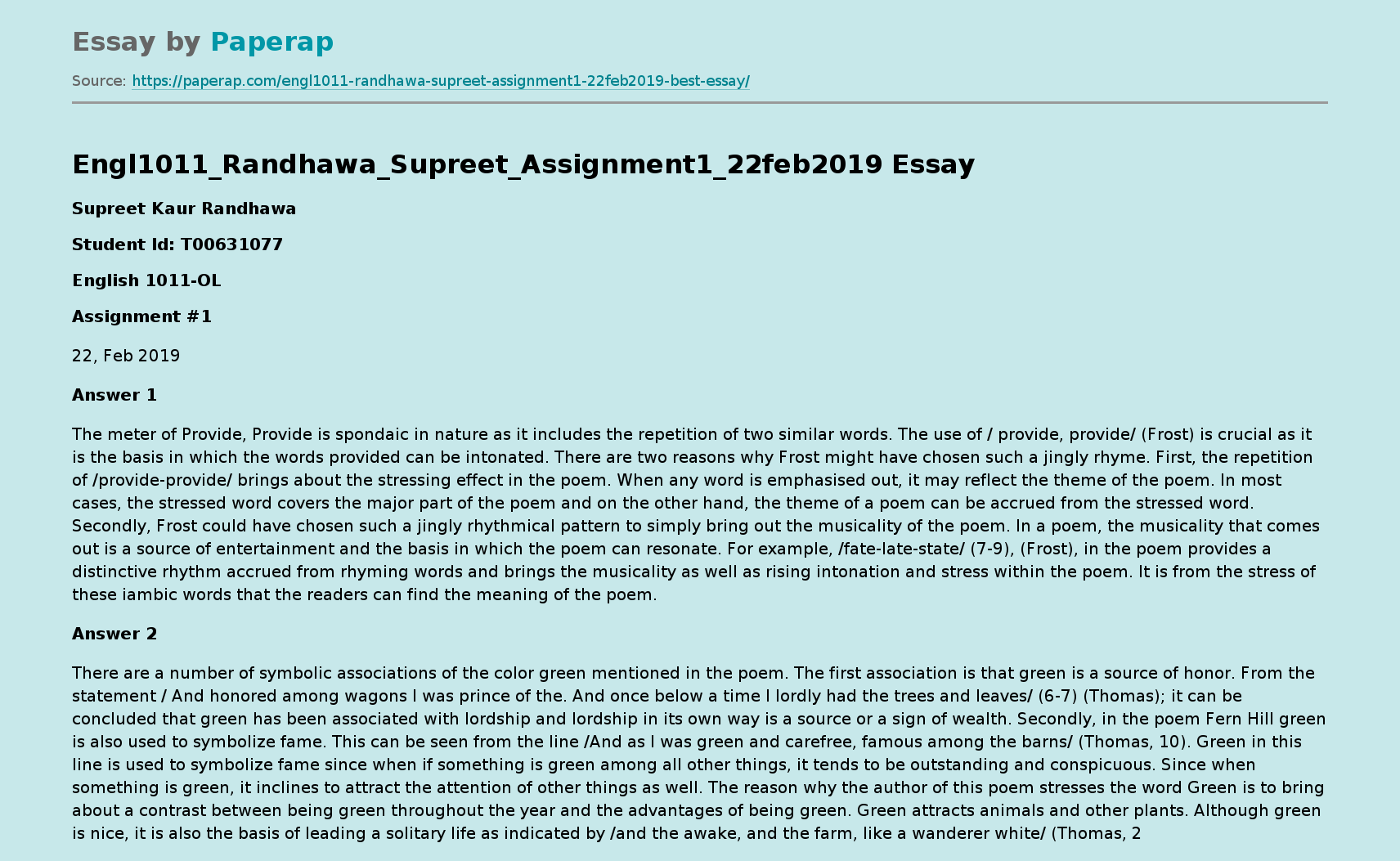Supreet Kaur Randhawa
Student Id: T00631077
English 1011-OL
Assignment #1
22, Feb 2019
Answer 1
The meter of Provide, Provide is spondaic in nature as it includes the repetition of two similar words. The use of / provide, provide/ (Frost) is crucial as it is the basis in which the words provided can be intonated. There are two reasons why Frost might have chosen such a jingly rhyme. First, the repetition of /provide-provide/ brings about the stressing effect in the poem. When any word is emphasised out, it may reflect the theme of the poem.
In most cases, the stressed word covers the major part of the poem and on the other hand, the theme of a poem can be accrued from the stressed word. Secondly, Frost could have chosen such a jingly rhythmical pattern to simply bring out the musicality of the poem. In a poem, the musicality that comes out is a source of entertainment and the basis in which the poem can resonate.
For example, /fate-late-state/ (7-9), (Frost), in the poem provides a distinctive rhythm accrued from rhyming words and brings the musicality as well as rising intonation and stress within the poem. It is from the stress of these iambic words that the readers can find the meaning of the poem.
Answer 2
There are a number of symbolic associations of the color green mentioned in the poem. The first association is that green is a source of honor. From the statement / And honored among wagons I was prince of the . And once below a time I lordly had the trees and leaves/ (6-7) (Thomas); it can be concluded that green has been associated with lordship and lordship in its own way is a source or a sign of wealth.
Secondly, in the poem Fern Hill green is also used to symbolize fame. This can be seen from the line /And as I was green and carefree, famous among the barns/ (Thomas, 10). Green in this line is used to symbolize fame since when if something is green among all other things, it tends to be outstanding and conspicuous. Since when something is green, it inclines to attract the attention of other things as well. The reason why the author of this poem stresses the word Green is to bring about a contrast between being green throughout the year and the advantages of being green. Green attracts animals and other plants. Although green is nice, it is also the basis of leading a solitary life as indicated by /and the awake, and the farm, like a wanderer white/ (Thomas, 28-29).
Answer 3
Overall, the poem must be thought as a poem of love and there are also images used and Celtic ideas present. In the illustration of the meeting, the addressee could be anyone in the poem as it is related to the story of encounter. While describing the encounter, simile and metaphor are used which helped to bring out the theme of the poem. Moreover, the second stanza of the poem represents a metaphor eyes were trees where the eyes of the lady were compared to trees. Similarly, readers may become able to compare the eyes to hazel trees. Also, simile is used particularly in the fourth stanza. He calls the lady plump as finch who lived as a salmon, gay as silk and proud as Brahmin. The use of terms in the sentence may look like a description of the lady, however it is the wisdom that is being compared to her. Hazel trees are reflected as a tree of wisdom with which the lady is being compared. The use of simile and metaphors are used to some extent in same way and not different.
Answer 4
The use of alliteration, assonance and consonance has been widely used by E.E Cumming in his poem. Starting with alliteration, there a number of situations where Cumming employs the use of it. For example, the use of alliteration is observed in the lines /love is thicker than forget- thinner than recall- more frequent than fail/ (line 1, 2 and 4) (Cummings and George). In this case, there is the repetition of sound t in the first line, sound t in the second line and sound f in the fourth line. The use of the initial consonant has made an impressive effect on the poem that it brings out the musicality and rhythm within the poem. This makes the poem more entertaining and interesting to read. Consonance being the repetition of consonant sounds within a word in a line is also evident in this particular poem. For example, in stanza 4, /it is most sane and sunly/, there is the repetition of sound s. The effect of this style brings out musicality and helps the reader remember the much-stressed words in the poem. It also helps in creating emphasis and ringing out the theme within the poem as well. The use of assonance has also been richly employed within the poem where there are instances of vowel sounds being repeated. For example, /less bigger than the least begin/, here the vowel sounds e and I have been repeated. The effect of the use of this feature is that it helps in building rhythm hence musicality.
Answer 5
The prime symbol of the poem The wild swans at Coole is about the swans. The swans are the most prominent and prime symbol of the poem. Swans are the symbols of beauty, permanence and energy (Yeats). The poet symbolizes swans as the representation of beauty however they do not age in the way the poet does. Also, they are not aware or conscious about pain and weariness, again the same way the poet does. The swans remain unchanged even though everything has been changed in the speakers life. Beauty, grace and energy are symbolized with the swan and the poem endows them with a mythical status that manifests them as divine creatures unaffected and unmoved by time. They are also immune to pain and weariness. The poet is certainly happy to see the swans and he is more than impressed however, they also remind him regarding his age. He reminds the pain of getting old and the inevitable fact, death. Therefore, swans put several thoughts in poets mind which are combination of positive as well as negative. In poetry and literature, birds are often used to represent freedom and flight away from the human life. In the same way the swans certainly offer an escape from the thoughts and fear of getting old to the speaker. Also, it might as well represent Yeats beloved Maud Gonne who did not accept his love.
Part B
From a close analysis of this poem, the main theme that comes out is the theme of separation/abandonment. In most cases, separation of families is caused by war, work and even death. The basis of this conclusion is based on the first line of the poem, /Father is gone again/ (1). From this line, it is clear that the persona is affirming the fact that their father is gone again. There is also a sense of fear which has been backed up by / the streets empty everyone inside, listening to radios / (2). From the later statement, the act of everyone being inside brings out the possibility of fear resulting from war or disaster. People being glued next to their radios is a likely indication that people are listening at least to get pieces of information about what the development outside there is like. The characters in this poem are also useful in bringing out the main theme of separation/abandonment and maybe fear. For instance, from this poem, the main characters are young children and mothers likely to be seeking refuge. That is the reason why the persona says /Mother opens her old muskrat coat, pulls me inside/ (10-11). From these lines, it is clear that mother is protecting their children as they wade through the ice-covered surface. When mothers are the only ones protecting their children, then it means that their fathers are gone possible to war or to work; basically, out their trying to find a solution to the problem at hand. This is where the theme of involuntary separation sets in as the main theme of the poem.
Based on the poem, the theme of separation is closely related to fear and given the idea that the persona seeks tracks of one animal crossing the open and moving towards the personas home. This is vivid from, / the tracks of one animal crossing the open, strange and nocturnal, moving towards home/, (Uyeda et al). From this line, fear is cemented by the idea that there is tracks of one animal, that animal is nocturnal and heading towards where the persona and his/her mother lives. This is a total separation since the father is gone, there is an animal which has headed towards home and there is nowhere else to go. From these points, one is justified to conclude that the theme of separation takes the center stage. However, there are other sub themes which cements the main theme. In that case, fear, abandonment and loneliness converge towards the main theme which is separation. The separation therefore could have been cause by war, disaster and other things which could warrant displacement after separation between family members. The actions, thought, fears and what the characters presented by the poem say is also a contributing factor as far as the development of theme in this poem is concerned.
Works Cited
Cummings, E E, and George J. Firmage. 22 and 50 Poems. New York: Liveright, 2000. Print.
Frost, Robert. “Provide Provide.” New Frontier. 1.4 (1934). Print.
Thomas, Dylan, and Dylan Thomas. Dylan Thomas Selected Poems, 1934-1952., 2003. Print.
Uyeda, Leslie, Lorna Crozier, and Kathleen Speakman. Mother and I, Walking: For Soprano and Piano., 2014. Musical score.
Yeats, W B, and George Bornstein. The Wild Swans at Coole (1919)., 2017.Print.
Engl1011_Randhawa_Supreet_Assignment1_22feb2019. (2019, Nov 22). Retrieved from https://paperap.com/engl1011-randhawa-supreet-assignment1-22feb2019-best-essay/

